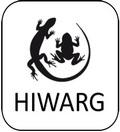About us
About Us
Hampshire is fortunate that the county covers a huge geographic area and a very diverse breadth of habitat including: the Isle of Wight, the New Forest National Park, the South Downs National Park, as well as many other unspoiled areas, including Woolmer Forest.
It is therefore unsurprising that we are host to 12 out of the 13 native amphibians and reptiles in UK, including rarities such as the Natterjack Toad, Sand Lizard and Smooth Snake, and wherever you live in the county there will be opportunities to survey and monitor an assemblage of amphibian and reptile species.
HIWARG formed in the Autumn of 2018 and is an affiliated independent ARG-UK group. The group focus is conservation of native UK species essentially around habitat management, surveying, public engagement, volunteer training & doing as much as possible to understand & protect the native species in the county.
All members are volunteers with a common interest.
If you have some spare time and would like to be involved with HIWARG, maybe you have taken a photo of a reptile or amphibian and would like it identified or maybe you have some other query, then please do get in contact info@hiwarg.org.uk
CONSERVATION THROUGH EMPATHY BY ENGAGEMENT
We now have a new website. Please visit https://hiwarg.org/
Visit HIWARG's Redbubble Shop to support our work www.redbubble.com/people/HIWARG/shop
News
News
Big Green Frog Hunt 2024
We are interested in the locations and distribution of the non-native Pelophylax water frog species wherever they are found in Hampshire and the IoW, but are especially keen to know if you have seen or heard them in the following locations:
Aldershot, Farnborough, Fleet and Odiham, (especially on the Basingstoke Canal)
Alton, Bentley, Alice Holt and Rowledge areas, especially along the River Way catchment.
Alresford area, mostly from the roads and footpaths around the ponds and watercress bed.
The Pig Bush, Kings Hat and Ipley inclosure areas of the New Forest.
If you are out and about in the above areas over the next few weeks, listen out for some unusual, and loud, frog calls... watch the video for an example.
There are four species of water/green frogs (Pelophylax species) in Hampshire and all have a roughly similar call. We have used the edible frog call as an example in the linked video as that is roughly somewhere in the middle of the range.
As a general rule of thumb, if you can see the calling males and they have pale/white vocal sacs on either side of their jaw when inflated, they will most likely be one of the pool frog species, if they have dark grey vocal sacs and are very large frogs they will most likely be marsh frogs and pale/mid grey vocal sacs most likely to be edible frogs.
As always, log your sightings on www.recordpool.org.uk and share any photos or videos on this group if you can. Thanks ![]()
Calling edible frogs: https://www.youtube.com/watch?v=-mtaXVXaw1w
If you are on Facebook you will find more details here: https://www.facebook.com/groups/455730808110700/permalink/2170339753316455/
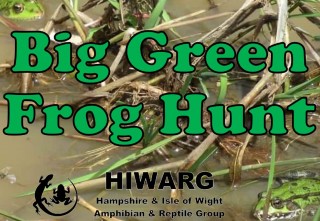
Midwife Toads in the Winchester (Littleton, Weeke and Teg Down areas in particular) and possibly Colden Common areas
Despite the lack of records, there is an anecdotal comment to suggest that Midwife Toads were known from the Winchester area and so we are reaching out to residents for their help in finding these elusive toads. By far the best way to identify the presence of Midwife Toads is by their calls, which has been likened to “an electronic beep, like a smoke alarm with a dying battery or a New Age car alarm” by Steve Allain, one of the lead national researchers of Midwife Toads.
With tonights drizzling rain, it is more likely that they will start calling if thay are still around. Visit the following links to hear a sample of Midwife Toads calling
http://stevenallain.co.uk/.../scifri-whats-that-beeping...
www.youtube.com/watch?v=SVPK899UwV8
Midwife Toads are smaller than our native toads, with adults reaching around 5cm in length. They can also be distinguished by their eyes, if you are lucky enough to spot one, which have vertical pupils as opposed to horizontal/oval pupils of our two native toads. A big difference with these toads is that they are not as reliant on ponds for breeding, as the male toads carry the eggs wrapped around their back legs, hence their name. Breeding usually takes place between April and June so they should have been calling for a few weeks now, but the dry weather may have affected this..
We are hoping that residents in the Winchester area (especially Littleton, Weeke and Teg Down) will be willing to help by listening out on warm damp nights for the “beeping” toads. If you do hear these calls it would be really helpful if you can record the calls on your phone, or take photos if you manage to see one.
For all sightings/recordings, please contact us on:
HIWARG Amphibian Officer: amphibians@hiwarg.org.uk or HIWARG on Facebook www.facebook.com/groups/455730808110700
Steve Allain: www.facebook.com/SJRAllain or https://twitter.com/stevoallain
Midwife Toads in Hampshire 2023
Midwife Toads are not a native species to the UK, but have been found in several colonies in parts of the country. Hampshire has been named as one of these locations in several sources, but there are no actual records that we are aware of. Despite the lack of records, there is an anecdotal comment to suggest that Midwife Toads were known from the Littleton area and so we are reaching out to residents for their help in recording these elusive toads.
Midwife Toads are smaller than our native toads, with adults reaching around 5cm in length. They can also be distinguished by their eyes, if you are lucky enough to spot one, which have vertical pupils as opposed to horizontal/oval pupils of our two native toads. By far the best way to identify the presence of Midwife Toads is by their calls, which has been likened to “an electronic beep, like a smoke alarm with a dying battery or a New Age car alarm” by Steve Allain, one of the lead national researchers of Midwife Toads. A big difference with these toads is that they are not as reliant on ponds for breeding, as the male toads carry the eggs wrapped around their back legs, hence their name. Breeding usually takes place between April and June so they should have been calling for a few weeks now. Visit Steve’s blog to hear a sample of Midwife Toads calling http://stevenallain.co.uk/.../scifri-whats-that-beeping... you can also hear individual calls on this Youtube link www.youtube.com/watch?v=SVPK899UwV8
We are hoping that residents in the Winchester area (especially Littleton, Weeke and Teg Down) will be willing to help both Steve Allain and HIWARG, by listening out on warm damp nights for the “beeping” toads. If you do hear these calls it would be really helpful if you can record the calls on your phone, or take photos if you manage to see one.
For all sightings/recordings, please contact us on:
HIWARG Amphibian Officer: amphibians@hiwarg.org.uk or HIWARG on Facebook www.facebook.com/groups/455730808110700
Steve Allain: www.facebook.com/SJRAllain or https://twitter.com/stevoallain
Stuck for something to do over the Easter Weekend?
Big Green Frog Hunts are more exciting, than Easter egg hunts (although maybe not as tasty).
Conditions are not the best, but with sunny spells and temperatures tickling the 'teens over the weekend, the chances of spotting water frogs are on the increase. Pack a picnic, check the area on the map below and go for a walk. Take a camera and record your sightings and photos on www.recordpool.org.uk
Water frogs are non-native frogs in the Pelophylax group. They are a tricky group to ID to species accurately in the field so we typically call them water frogs.
As they are a complex of species, adult size can range from a similar build to our common frogs up to 50% larger. Other ID features are:
- A very rounded nose/jaw, almost conical;
- Eyes are more prominant and closer together than on common frogs;
- They lack the "bandit" eye patch behind the eyes, as with common frogs;
- Can have a yellow/green line down their spine, but not always present/obvious;
- Lateral ridges on either side of their back;
- Almost always in or close to water, often basking in the sun;
- Will almost always spot you first, jumping into the water and disappearing immediately;
- Calling males will have two vocals sacs, either side of their jaw. (common frogs call with their throat.)
- Male calls sound like a cackling, croaking, quacking sound... they can sometimes be called laughing frogs.
We have four water frogs in our area, Marsh frog, Edible frog, Southern clade pool frog and Perez's frog. The following video will give you a rough idea of what to look for and hopefully listen out for: www.youtube.com/watch?v=472zFshwasA
You can download a fab ID guide at www.arguk.org/info-advice/id-guides/441-amphibian-id-guide-revised-2019-pdf

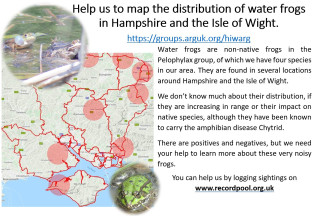
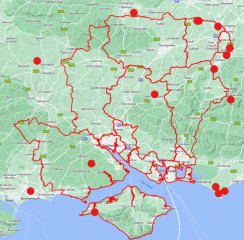
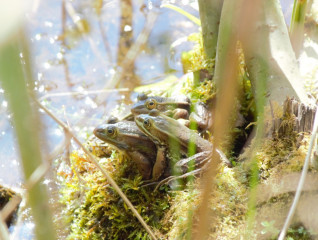
Toads need your help
Toads and other amphibians have started migrating to their breeding ponds, but often get killed on our roads. There are three registered toad crossings on Froglife's Toads on Roads Map, but only two are manned by patrollers. If you can help save toads and other amphibians by becoming a Toad Patroller, visit https://www.froglife.org/what-we-do/toads-on-roads/tormap/ and find your nearest crossing.
If you want to know what Toad Patrols do, you can read more here https://www.froglife.org/wp-content/uploads/2023/01/Patrol-Pack-2023-compressed_compressed.pdf
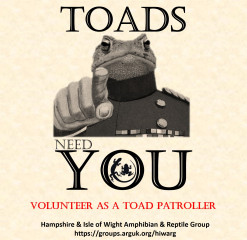
Events
Events
Past Events
Show Upcoming EventsCrassula Bashula: Winter is Coming
Sat 29th October, 2022 - Sat 29th October, 2022
Winter is coming, and we need to beat back the Crassula before it regains its grip of this important pond with five species of amphibians.
No experience necessary as I will give a full briefing before we start. The more volunteers we have on the day, the bigger effect we will have.
We will be working slowly and methodically as accuracy and attention to detail is much more important than a hack and slash approach. This session will be focussed more on pulling up new shoots, so very light work, but a lot of bending/kneeling.
Bring:
> water/drinks to keep yourself hydrated
> comfortable, but sensible footwear for a practical activity (boots, wellies, but no open toe/back footwear)
>kneeling may be involved, so kneepads/mats will be useful
> small hand tools trowels etc, but rakes will be useful for tidying up*
> work gloves*
> buckets/garden trugs etc for moving small loads of waste*
> snacks/something to eat
*Please make sure that your footwear and tools have been cleaned and disinfected before and after the event as per biosecurity guidelines:
1. Use brush to scrub off any debris, plant fragments, mud
etc.
2. Rinse with water (pond water will suffice).
3. Soak in 4% bleach solution for at least 5 minutes, or Virkon for at least one minute (5 minutes where Bsal is
suspected).
4. Rinse with clean water.
5. If possible, allow to dry for before next use.
6. Keep field equipment inside plastic bags during transit and storage (after thorough drying) to reduce the
chance of transmitting pathogens.
For more details read Advice Note 4: https://www.arguk.org/info-advice/advice-notes/324-advice-note-4-amphibian-disease-precautions-a-guide-for-uk-fieldworkers-pdf-2
Meet at the village green and park along Tylney Lane towards the Old House at Home pub. If we get a few people attending. I will direct parking as appropriate. Tylney Ln, Newnham Green, Hook RG27 9AH 10am to 1pm
Hurn Forest Habitat Management 3
Sat 29th October, 2022 - Sat 29th October, 2022
10am to 1pm
A joint event with DARN. Clearing Birch and Pine from heather with hand tools. Please bring drink, snack, gardening gloves, waterproofs. Also bring loppers and bow saw if you have them - some tools will be available. We look forward to seeing you there!
Hurn Forest, Boundary Lane Forestry England Car Park (free) BH24 2SE off A31/St Leonards.
Hurn Forest Habitat Management 4
Sun 30th October, 2022 - Sun 30th October, 2022
10am to 1pm
A joint event with DARN. Clearing Birch and Pine from heather with hand tools. Please bring drink, snack, gardening gloves, waterproofs. Also bring loppers and bow saw if you have them - some tools will be available. We look forward to seeing you there!
Hurn Forest, Boundary Lane Forestry England Car Park (free) BH24 2SE off A31/St Leonards
Crassula Bashula: North Hampshire
Sat 12th November, 2022 - Sat 12th November, 2022
Saturday 12 Nov 2022 10am to 1pm
Winter is coming, and we need to beat back the Crassula and branched bur reed before they regain their grip of this important pond with five species of amphibians.
No experience necessary as I will give a full briefing before we start. The more volunteers we have on the day, the bigger effect we will have.
We will be working slowly and methodically as accuracy and attention to detail is much more important than a hack and slash approach. This session will be focussed more on pulling up new shoots, so very light work, but a lot of bending/kneeling.
Bring:
water/drinks to keep yourself hydrated
comfortable, but sensible footwear for a practical activity (boots, wellies, but no open toe/back footwear)
kneeling may be involved, so kneepads/mats will be useful
small hand tools trowels etc, but rakes will be useful for tidying up*
work gloves*
buckets/garden trugs etc for moving small loads of waste* (very important)
snacks/something to eat
*Please make sure that your footwear and tools have been cleaned and disinfected before and after the event as per biosecurity guidelines:
- Use brush to scrub off any debris, plant fragments, mud
etc. - Rinse with water (pond water will suffice).
- Soak in 4% bleach solution for at least 5 minutes, or Virkon for at least one minute (5 minutes where Bsal is
suspected). - Rinse with clean water.
- If possible, allow to dry for before next use.
- Keep field equipment inside plastic bags during transit and storage (after thorough drying) to reduce the
chance of transmitting pathogens.
For more details read Advice Note 4: https://www.arguk.org/.../324-advice-note-4-amphibian...
Meet at the Tylney Lane, Newnham Green, RG27 9AJ and park along Tylney Lane towards the Old House at Home pub. If we get a few people attending. I will direct parking as appropriate.
ARC-BHS Joint Scientific Meeting 2022
Sat 3rd December, 2022 - Sat 3rd December, 2022
The Joint Scientific Meeting run by ARC and the British Herpetological Society (BHS) will be held in person at the Bournemouth Natural Science Society museum on Saturday 3rd December 2022. This is a very popular one day conference with science and research based presentations from the UK and overseas and ends with a raffle which raises funds for various great herpetofauna related causes.
Pond management
Sat 16th September, 2023 - Sat 16th September, 2023
The Street, Rotherwick, RG27 9BL
9.30am to 1pm
We will meet at the village pond (near Rotherwick Church), but parking will be road side in the village, so you may need to park your car a small walk away. Please ensure that you park appropriately and avoid blocking access or gateways.
We will be manually removing vegetation in a pond to help create some open water when the pond fills over the winter. The pond is home to all three native species of newts, including the protected great crested newt. No experience is necessary as we will give a full briefing before we start. The more volunteers we have on the day, the bigger effect we will have on enhancing the ponds habitats for wildlife.
The work will involve manually pulling up mostly shallow rooted vegetation, but we will also use hand tools such as spades and hand trowels. The cleared vegetation will be piled up for a later collection. We will start at 9.30am and finish at 1pm, with a break part way through.
Please bring:
Water/drinks to keep yourself hydrated
Comfortable, but sensible footwear for a practical activity (boots, wellies, but no open toe/back footwear)
Spades/forks, small hand tools trowels etc, but rakes will also be useful for tidying up
Gardening/work gloves
Buckets/garden trugs etc for moving small loads of waste
Snacks/something to eat during the break
To keep the risk of spreading unwanted plants and animals, either to or from the pond, please follow the Check, Clean, Dry guidelines: https://www.nonnativespecies.org/what.../check-clean-dry/
Please email info@hiwarg.org.uk if you are intending to join us
Crassula Bashula: The Third Season
Sat 23rd September, 2023 - Sat 23rd September, 2023
23 Sept 2023 9.30am to 12.30pm
Tylney Lane, Newnham, RG27 9AJ
Autumn is on its way and we need to beat back the Crassula before it regains its grip of this important pond with five species of amphibians, including an exceptional population of great crested newts.
If you were not aware, "Crassula Bashula" is our annual pond management of an pond with affected by the invasive non-native Crassula helmsii or New Zealand Pygmyweed.
No experience necessary as I will give a full briefing before we start. The more volunteers we have on the day, the bigger effect we will have on knocking the Crassula back for next years growth.
We will be working slowly and methodically as accuracy and attention to detail is much more important than a hack and slash approach. This session will be cutting the Crassula above the waterline into turves and moving to compost heap nearby, so there is a lot of bending/kneeling.
Please bring:
- water/drinks to keep yourself hydrated
- comfortable, but sensible footwear for a practical activity (boots, wellies, but no open toe/back footwear)
- kneeling may be involved, so kneepads/mats will be useful
- spades to cut the Crassula turves, small hand tools trowels etc, and rakes will be useful for tidying up*
- gardening/work gloves
- buckets/garden trugs etc for moving small loads of waste (very important)
- snacks/something to eat
IMPORTANT
Please make sure that your footwear and tools have been cleaned and disinfected before and after the event as per biosecurity guidelines:
1. Use brush to scrub off any debris, plant fragments, mud etc.
2. Rinse with water
3. Soak in 4% bleach solution for at least 5 minutes, or Virkon for at least one minute
4. Rinse with clean water.
5. If possible, allow to dry for before next use.
For more details read Advice Note 4: https://www.arguk.org/.../324-advice-note-4.../file
Meet at the village green and park along Tylney Lane towards the Old House at Home pub. If we get a few people attending. I will direct parking as appropriate.
SAT Nav address: Tylney Lane, Newnham, RG27 9AJ
If you are attending, please sign up at https://fb.me/e/4o9RxJKCP or email amphibians@hiwarg.org.uk
Alresford Apple Day at St John's Church
Sat 7th October, 2023
HIWARG are going to have a stall at the Alresford Apple Day at St John's Church, New Alresford a site which is a SINC for slowworms and HIWARG have had involvement with the management of the wild area for a number of years now.
Looking for a few folks to help out on the day, helping to enthuse visitors to the event about the local herp species and encourage them to log their records.
As a bonus, you'll probably get to see our very own celebrity Jonathon Cranfield performing... ![]()
If you are able to help, please visit https://fb.me/e/1wqfwAC4K and select "going".
Rotherwick Pond
Sat 28th October, 2023
Parking is just inside the entrance to Tylney Hall golf club, at the junction of Post Horn Lane and Stroud's Green Lane. Turn into the private road and park on the right under the trees.
RG27 9AZ W3W: emblem.baroness.stored
Meet at the pond: The Street, Street End, Rotherwick, RG27 9BL W3W: torso.coasted.clenching
This should take far less than the two hours allowed as we are only removing some of the mature reedmace.
We will be manually removing reedmace to reduce its coverage, but it will be a wader job for those pulling, who will pass waste vegetation back to those with wellies for removal from the pond.
The pond is home to all three native species of newts, including the protected great crested newt. No experience is necessary as we will give a full briefing before we start. We only need a small group for this activity, so if you want to join us for habitat management, the crassula clearance and heathland management will be a higher priority.
We will start at 9.30am and finish no later than 11.30am.
Please bring:
Water/drinks to keep yourself hydrated
Comfortable, but sensible footwear for a practical activity (boots, wellies, waders if you have them)
Rakes will also be useful for tidying up
Gardening/work gloves
To keep the risk of spreading unwanted plants and animals, either to or from the pond, please follow the Check, Clean, Dry guidelines: https://www.nonnativespecies.org/what.../check-clean-dry/
If you are attending, please visit https://fb.me/e/2NXWqH9Dr and select "Going" or email amphibians@hiwarg.org.uk
Heath Warren Scrub Clearance
Sat 4th November, 2023
Full details to be confirmed, so watch this space.
Parking is available at: Bramshill Forest Car Park, Bramshill Road, RG27 0PR
W3W: learn.tumblers.misty
OSGR: SU 76026 61314
Working at Heath Warren Flashes:
W3W: mows.fond.heaven
OSGR: SU 76701 59837
It is a fair walk from the car park to the work area so I will be looking into different access options for the day. If you want to attend, please keep watching these details for updates.
We will be clearing silver birch and willow scrub encroachment in the wider area, and are hoping for a large group of volunteers. We are partnering up with Forestry England, the Thames Basin Heath Partnership team and hopefully other voluntary groups.
Tools will be available on the day, but you are welcome to bring your own. You will need work/gardening gloves, rough outdoor clothing, with sturdy footwear and to dress according to the weather conditions at the time.
FE are providing a range of tools, including loppers and tree poppers and also a welfare van with refreshments and a toilet.
This event will be updated as details are confirmed.
Join up or Log In
Join up or Log In
Members sign in here

OR
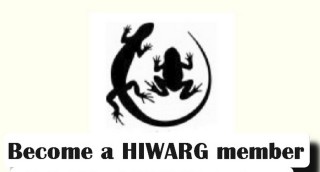
Membership costs just £6.00 per year as a subscription that can be cancelled at any time.
Your membership will help HIWARG to protect the amphibians & reptile of Hampshire.
Be aware of and take part in conservation opportunities, surveys and many other activities across the county.
Click here to go directly to PayPal to subscribe as a member:
Donate to HIWARG
Donate to HIWARG
Info & ID guides
Info & ID guides
Identification Guides
Amphibian Identification - downloadable colour cards : a great ID guide from ARG UK/ARC
Newt Eggs & Larvae - downloadable colour cards : an excerpt from the above guide, specifically on newt eggs and larvae
Its a small newt but which one : a HIWARG guide to help differentiate smooth newts and palmate newts
Reptile Identification - downloadable colour cards : a great ID guide from ARG UK/ARC
Non-Native Species ID Sheets (NNSS Website) : ID sheets from the Non Native Species Secretariat
Alien Amphibian and Reptile Species in the UK : A bilingual guide (English/Welsh) from ARC
Projects & Citizen Science
#BigGreenFrogHunt: Southern Clade Pool Frogs calling A YouTube video of southern clade pool frogs calling in North Hampshire
#BigGreenFrogHunt: Marsh frogs calling
DARN's 'Slow Worms in Churchyards' project
'Amphibians & Reptiles on Allotments' Introduction Leaflet
"Spawn Spotters" presentation 12 Jan 2021
Toad Patrol presentation 12 Jan 2021
Gotta love a larva presentation 9 July 2021
HIWARG Video: Spawn Spotters and Toad Patrols Jan 2021
HIWARG Video: Amphibian surveys: ID'S & Survey Methods March 2021
Habitat Management and Creation
![]() Reptile Habitat Management Handbook
Reptile Habitat Management Handbook
![]() Amphibian Habitat Management Handbook
Amphibian Habitat Management Handbook
Creating Garden Ponds - downloadable booklet
Creating Ponds for Amphibians and Reptiles (Freshwater Habitats Trust)
Guide to the Restoration, Creation and Management of Ponds (Freshwater Habitats Trust)
Habitat Management guides (Buglife) - Not specifically herp based but a great set of guides
How to Create Invertebrate and Reptile Mounds (Magnificent Meadows)
Creating Grass Snake Egg-laying Heaps (ARG UK and RAVON)
Advice and Information
ARC's "Dogs and Adders" Advice Sheet
"There is a Snake in my Garden - What can I do?" (ARG UK)
Policies/Health & Safety
HIWARG Safeguarding Policy and Protocols June 2020
Buddy System/Lone Working Procedures
ARG UK Generic Risk Assessment July2020
Herp Diseases - Recognise & Report
REPORT SICK OR DEAD WILDLIFE TO GARDEN WILDLIFE HEALTH
Advice Note-4: Amphibian disease precautions - a guide for UK fieldworkers
Reptile Slough Genebank - collection & submission of found sloughs
Garden Wildlife Health - Severe Perkinsea Infection (SPI)
Other
Fixing Enkamat to Gully Pots - Initial Findings in Sussex
Useful glossary of terms often used within the herpetological field. (Credit due - unknown)
Kids stuff - Educational items for the young ones
Pond pack Animal fact sheets Animal colouring sheets
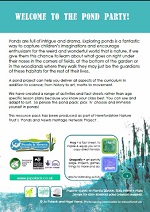
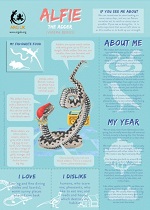
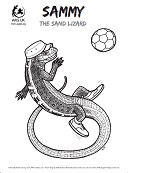
Photo gallery
Photo Gallery
Contact us
Contact Us
If you would like more information about HIWARG or have something to share with us, please get in touch via the link to our social media presence.
Upcoming Events
Upcoming events will be listed here.
Latest News
- Big Green Frog Hunt 2024
21/05/2024 6:16 pm - Midwife Toads in the Winchester (Littleton, Weeke and Teg Down areas in particular) and possibly Colden Common areas
18/06/2023 8:11 pm - Midwife Toads in Hampshire 2023
19/04/2023 11:05 pm - Stuck for something to do over the Easter Weekend?
05/04/2023 11:20 pm - Toads need your help
21/02/2023 12:23 am
© Hampshire And Isle of Wight Amphibian and Reptile Group (HIWARG)
Website hits: 58110
View All | Find out how to get a mini-website for your ARG
© ARG UK Local Groups mini-websites 2025
Wind powered websites by Aye-aye Design.
